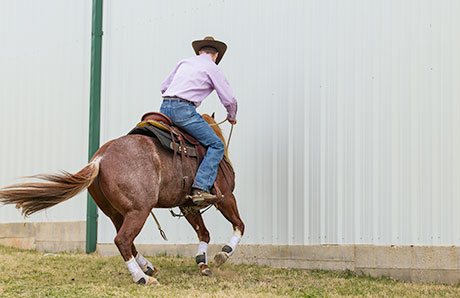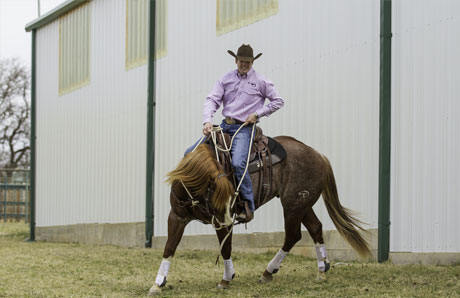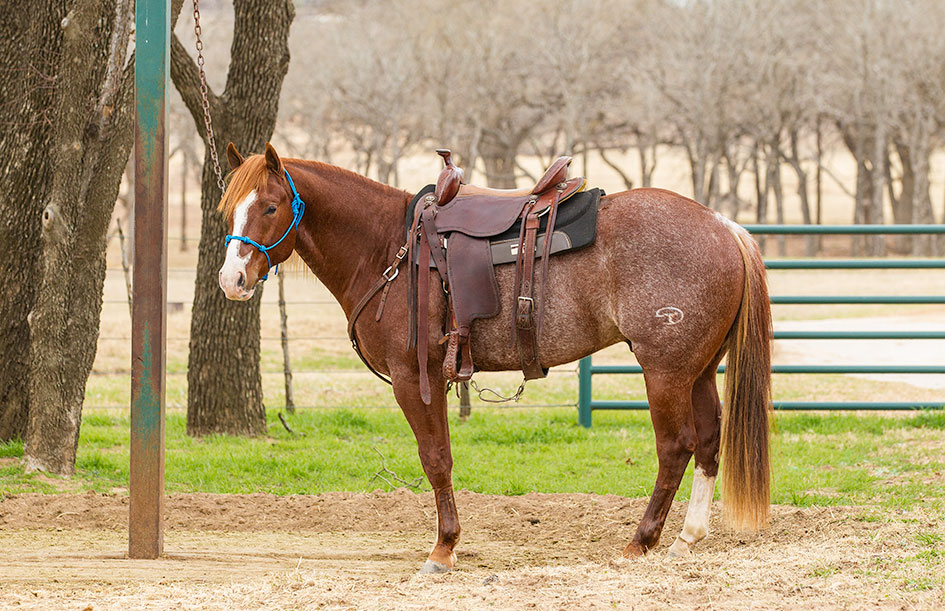I Don’t Wanna go!
Does your horse throw “I don’t wanna go tantrums” every time you try to ride him away from the barn? Or, when you turn him back toward the barn, does he start power walking or jigging home? If so, you’re not alone. Horses are social animals and quickly bond with one another, which can make them reluctant to leave the barn. In fact, how to correct a barn-sour horse is one of the most common questions I get asked. Horses that are barn sour are not only frustrating but dangerous, as they often rear or run backwards when they don’t want to leave the barn.
When I address barn-sour horses, I always tell people to think of their horse’s desire to get back to the barn like this: If you worked for me and I made you work all day in a field under the hot sun and at the end of the day, I took you to an air conditioned room, let you relax and gave you ice cream to eat, it wouldn’t take long for you to resent going out in the field and start looking forward to quitting time. If knockoff time was at 3, you’d want to leave the field at 2, and then 1, and pretty soon you wouldn’t even want to go to the field at all.
That’s exactly how your horse feels about leaving the barn. At the barn he gets to rest, relax, eat and socialize with his buddies. Out on the trail or in the arena, he has to work and get hot and sweaty. Which sounds like the better deal to you? When you stop and think about it, it’s no wonder that a lot of us have to deal with barn-sour horses.
A SYMPTOM OF A CAUSE
You might be able to get your horse 20 or 30 feet down the trail, and then he starts backing up, running sideways or rearing. You’re a picture of flailing reins and spurs as you try to persuade him to head away from the barn, but the more you try to make him leave the barn, the more violent and disrespectful he gets. To him, the barn is better than being ridden and worked hard. Horses are basically lazy creatures. They’d rather put in the least amount of effort as possible to get the day over and done with. Instead of making the horse leave the barn, give him a reason to want to leave.
In order for the horse to want to leave the barn, use a little reverse psychology. Instead of him thinking the barn is the best place to be, make him think being away from the barn is the better option. You’ll do that by working him hard at the barn, where he wants to be. I do a lot of serpentines, rollbacks and bending transitions. The more changes of direction you can make the horse do, the more he has to pay attention to you and concentrate on his job. When you’re working the horse, use your imagination. It doesn’t matter how you move his feet, just that you make him hustle and do a lot of changes of direction.
If you have a green horse that isn’t advanced in his training or you’re not confident enough as a rider to do rollbacks, you can still make him hustle his feet by trotting or loping him in circles or weaving in and out of objects around the barn. It doesn’t matter what you do, just get his feet moving. Instead of viewing your horse’s problem as a negative, turn it into a positive. In other words, don’t just get him hot and sweaty, train on him at the same time to soften and supple his five body parts and increase his responsiveness.
Concentrating on moving the horse’s feet also gives you a job to do instead of focusing on your horse’s bad behavior. So if he’s hopping up like he wants to rear or if he’s rushing backwards, don’t worry about him rearing, just go put his feet to work. If you’re constantly redirecting his feet, he won’t be able to back up or rear. A horse can’t rear if his feet are moving.
After working the horse 10 to 15 minutes, walk him away from the barn and let him rest. While he’s resting, put him on a big, loose rein and rub his neck. Show him that being away from the barn is a good thing—he gets to rest and feel comfortable.
Let the horse rest a good five to 10 minutes before taking him back to the barn and working him again. If your horse is in a hurry to get back to the barn and doesn’t want to stand still when you rest him, he’s just telling you that you need to go back to the barn and work him harder and try again. If he wants to trot or lope back to the barn, let him. It won’t take long before he realizes that he’s only hurrying back to hard work.




Work the horse at the barn, hustling his feet and constantly changing directions. You can do rollbacks, serpentines, or move him in circles. What you do with the horse is up to you. Just remember to move his feet with energy!

Rest the horse away from the barn on a big, loose rein.
Concentrate on getting the horse to take the bait—standing still is much easier than going back to the barn and working hard. I sound like a broken record here, but again, when you work him at the barn, make his feet hustle. If you just let him lollygag around like “Come on, Precious, you need to move your feet,” he won’t catch on to the lesson. You have to give him a reason to want to leave the barn.
Initially, you’ll have to establish a starting point as to how far away from the barn you can take the horse. Each time you rest him, you can gradually increase the distance from the barn. The first time you take him away from the barn, you might only get 30 feet away from it. Or, if your horse is really barn sour, you may only get him 10 feet away from the barn. Where your starting point is doesn’t matter. What is important is that you establish one. Once you have a starting point established, then you can gradually build on it.
The most important thing to remember is to quit the horse before he quits you. If you think the horse is going to stop 45 feet away from the barn, then you stop him and let him rest 43 feet away from the barn. You don’t want to turn going away from the barn into a fight, otherwise you’ll defeat the purpose of the exercise.
Practice working the horse at the barn and resting him away from it four or five rides in a row before even thinking about trail riding. By the time you take him on the trail, you want the horse to be thinking, “Man, I’m happy to leave the barn, there’s nothing back there for me except hard work and sweat.”
FIXING THE PROBLEM IN REVERSE
Some people have the opposite problem with their horses. The horse might willingly leave the barn, but as soon as he’s turned toward home, he starts power walking back or grabs the bit and bolts for home. He’s in a hurry because he thinks the barn is the greatest place in the world. And why wouldn’t he? He gets unsaddled, washed off and fed there and he gets to socialize with his buddies.
With this type of horse, let him get back home. Once you’re there, instead of getting off his back and putting him away, hustle his feet. Repeat the same process I described earlier. Make the horse hustle his feet at the barn, then rest him away from the barn. Do that five or six times in a row so that the horse realizes that the barn isn’t necessarily the best place to be.
When you do get off him for the day, don’t immediately put him away. That’s like saying, “You were right! The faster you get home, the quicker you get to be with your buddies and eat.” Instead, safely tie him up for a few hours to the tree or post of knowledge. I love tying my horses up after a training session to let them soak on the day’s lesson. It not only stops the horse from anticipating getting back to his stall or being turned out, but it teaches him patience as well.
Even if your horse doesn’t rush back to the barn after you’ve worked him, it’s still a good idea to do some maintenance on him. When you get him back to the barn, do a couple of rollbacks or take him through a series of serpentines. Do something to make him move his feet and reinforce to him that just because he’s back at the barn, he’s not going to get an instant relief from work. Even if your horse is well behaved, you have to maintain the foundation you taught him. The last thing you want to do is get back to the barn and immediately unsaddle him, put him away and give him some grain. Remember, horses are nothing more than maintenance with legs.
SUCCESS TIPS:
Stay a step ahead of your horse.
One way to deter your horse from wanting to rush back to the barn is to come back to it on different paths. In other words, try not to always come back to the barn from the same trail. Or, when you do come back to the barn, work the horse, and then immediately ride him off on another trail. Stay a step ahead of him. I do this with my horses even when I’m riding them in the arena. All of my arenas have multiple gates I can take my horses in and out of, so I’m conscious of always leaving the arenas through different gates. That stops the horses from getting hooked on one particular gate and thinking it’s how they can escape work.
Dismount away from the barn.
For extreme cases of barn-sour horses, after implementing the fix I described, you can also dismount the horse away from the barn. Get off him, loosen up his girth and then hand walk him home. This just further plants in the horse’s mind that the barn doesn’t mean his workday is done. This isn’t necessary for most horses, but it certainly helps with extreme cases.

At the end of a ride, tie your horse to the tree or post of knowledge. This will curb his anticipation about getting back to the barn and give him time to soak on the day’s lesson.

Master Your horsemanship Skills
Like these tips? Join the No Worries Club and hone your skills with thousands of hours of Clinton’s easy, step-by-step method horse training videos.



